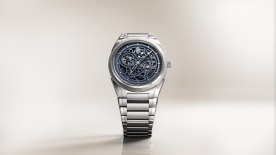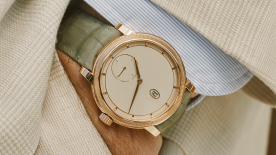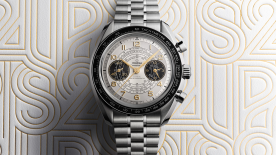Un excellent éditorial de Pierre Maillard, dans le dernier numéro de Europa Star : "Historiquement, la période est une des plus fastes qu'ait jamais connu l'horlogerie (à comparer peut-être à la période Art Déco, qui a vu naître tant d'icônes horlogères encore célébrées aujourd'hui)"...
 Photo: Orson Welles, Don Quichotte
Photo: Orson Welles, Don Quichotte Empires, royaumes et chevaliers horlogers
Un excellent éditorial de Pierre Maillard, dans le dernier numéro de "Europa Star" : "Historiquement, la période est une des plus fastes qu'ait jamais connu l'horlogerie (à comparer peut-être à la période Art Déco, qui a vu naître tant d'icônes horlogères encore célébrées aujourd'hui)"...
Les grands empires et royaumes horlogers qui se taillent la part du gâteau (le Swatch Groupe, Richemont, LVMH, Rolex, Seiko et quelques puissants indépendants comme Patek Philippe ou Chopard) ne cessent de se renforcer, comme le démontre le dernier mouvement en date sur cet échiquier très disputé: le rachat de Hublot par LVMH. Sans parler d'autres acquisitions, moins médiatiques mais parfois plus stratégiques, qui se déroulent dans l'ombre de la "sous-traitance" dont des pans entiers passsent avec armes et bagages dans un camp ou dans l'autre. Mais vu du point de vue de l'offre, du point de vue du consommateur, ce vaste territoire de l'horlogerie est au contraire en train de se fractionner, de s'émietter en une mosaïque de royaumes (de marques) qui tous défendent haut et fort leur propre blason. Car le consommateur "ordinaire" – je ne parle pas du collectionneur averti – n'a cure de savoir à qui peut bien appartenir telle ou telle marque. Ses critères sont tout autres: il en veut pour son goût et pour son argent, que ce soit réellement ou symboliquement. Les indépendants, les nouvelles marques et les horlogers isolés y ont vu une opportunité à ne pas manquer: vite se glissser dans les interstices de cette bataille. Mais encore faut-il parvenir à se faire entendre dans le vacarme de cette confrontation. Relativement démunis des extraordinaires moyens publicitaires dont les grands empires et royaumes ne se privent pas, ces Chevaliers solitaires cherchent à résoudre le dilemme en innovant et en lançant des concepts étonnants qui, pour un temps au moins, détournent l'attention à leur profit. Dans ce concert dissonnant, dans ce fourmillement d'idées il y a bien-sûr à prendre et à laisser. Nous n'avons pas la prétention de nous ériger en censeurs ou en distributeurs de bons et de mauvais points. Mais nous devons toutefois attirer l'attention sur de fréquentes confusions, afin tout simplement d'y voir un peu plus clair dans ce brouillard. Car il y a "innovation" et "innovation": toutes ne se valent pas. Il y a de même "manufacture" et "manufacture" car, à en lire la propagande des marques, on a l'impression que la Suisse abrite 620 manufactures (soit le nombre approximatif de marques). Combien de mouvements présentés comme étant "révolutionnaires" et vantés comme étant "conçus, construits et produits in-house", quand il s'agit souvent d'un petit mécanisme aditionnel sous-traité ou d'un affichage déplacé de 6h à 3h! Et à l'heure actuelle de la grande "foire aux métaux", combien d'alliages "utilisés dans l'industrie aéronautique" qui existent en fait depus 150 ans! Mais par ailleurs, s'il convient de chercher à discerner le réellement innovant du prétendu tel, il faut aussi se réjouir de l'incroyable vitalité actuelle. Historiquement, la période est une des plus fastes qu'ait jamais connu l'horlogerie (à comparer peut-être à la période Art Déco, qui a vu naître tant d'icônes horlogères encore célébrées aujourd'hui). Mais ce qui en restera, seule l'Histoire en décidera. Car on sait que tous les empires et tous les royaumes sont mortels. Et que les Chevaliers finissent souvent errants. Pierre Maillard
 SOURCE : Europa Star, juin-juillet 2008 (cliquez sur l'épée du chevalier ci-dessus)...
SOURCE : Europa Star, juin-juillet 2008 (cliquez sur l'épée du chevalier ci-dessus)... The empires, kingdoms, and knights of the watch table
Pierre MaillardThe great empires and kingdoms that make up the largest slice of the proverbial watchmaking pie (Swatch Group, Richemont, LVMH, Rolex, Seiko, and a few major independents such as Patek Philippe and Chopard) only continue to become greater. This was again demonstrated by the latest move on this highly competitive chessboard with the acquisition of Hublot by LVMH. While this purchase made headlines, many other much less publicized buy-outs take place behind the scenes and involve ‘subcontractors' that move lock, stock, and barrel into one camp or another. But from the point of view of the offer—and from the average consumer's viewpoint—this vast territory of watchmaking appears to be breaking up rather than consolidating. It seems to be splitting into a mosaic of kingdoms (the brands), which all stalwartly defend their honour and their realms. The reason consumers have this impression—I am not talking about well-informed collectors or aficionados—is because they don't pay attention or even care about which brand belongs to which group. They have other criteria for judging a brand: primarily it must meet or satisfy their own taste and their wallet, whether in real or symbolic terms. The independents, new brands, and lone watchmakers have seen an opportunity not to be missed in these consolidations—they must quickly slide into the cracks of this competitive combat. Ah, but creeping to the front lines is one thing, making themselves heard over the roar of the battle is quite another. Relatively impoverished compared to the extraordinary advertising allotments at the disposal of the great empires and kingdoms, these solitary knights try to resolve their dilemma by innovating and producing new designs that, for a time at least, divert attention to them. In this discordant chorus, in this welter of ideas, there are, of course, things to be taken and things to be left. We have no intention of becoming a censor or a critic of good and bad points. We must, however, draw attention to the frequent confusion in order to see a little clearer through the fog. As we know, there is ‘innovation' and then there is ‘innovation'. They are not all the same. In the same vein, there are ‘manufactures' and then there are ‘manufactures'. In reading the promotional material from the brands, we get the im-pression that Switzerland is home to 620 manufactures (or approximately the number of Swiss brands).
How many movements are presented as being ‘revolutionary' and vaunted as being ‘designed, constructed, and produced in-house' when this ‘rev-olution' often simply means that an additional—and subcontracted—mechanism has been added or that a display has been moved from 6 o'clock to 3 o'clock! During the current era of the ‘showcase of metals', how many alloys ‘used in the aerospace industry' have actually been around for the last 150 years? Moreover, while we might try to actually discern the truly inno-vative from the wannabes, we must also rejoice in the incredible vitality that is happening in watchmaking today. This period is one of the most prolific in the history of timekeeping (perhaps comparable to the Art DÉco period, which saw the birth of a great many watch icons that are still famous today). Which of today's plethora of products will still be ticking tomorrow? Only time will tell. We do know, however, that all the empires and all the kingdoms are, in the end, mortal, and that often the bravest of knights end up wandering.
Marques








